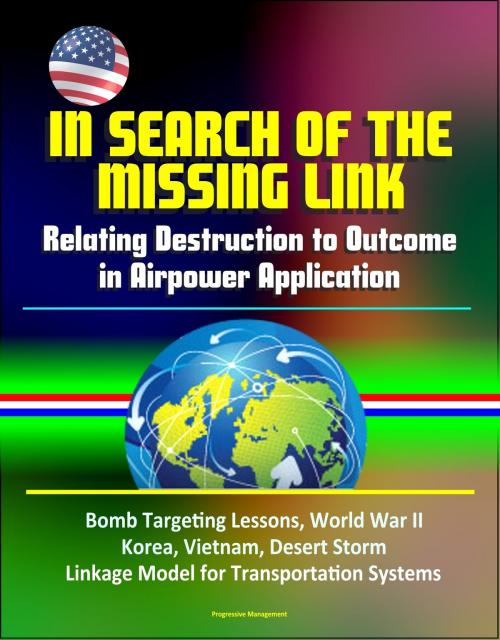In Search of the Missing Link: Relating Destruction to Outcome in Airpower Application - Bomb Targeting Lessons, World War II, Korea, Vietnam, Desert Storm, Linkage Model for Transportation Systems
Nonfiction, History, Military, Aviation, World War II| Author: | Progressive Management | ISBN: | 9781310961564 |
| Publisher: | Progressive Management | Publication: | April 15, 2016 |
| Imprint: | Smashwords Edition | Language: | English |
| Author: | Progressive Management |
| ISBN: | 9781310961564 |
| Publisher: | Progressive Management |
| Publication: | April 15, 2016 |
| Imprint: | Smashwords Edition |
| Language: | English |
This excellent report has been professionally converted for accurate flowing-text e-book format reproduction. Targeting has been the central problem of air strategy since the dawn of modern airpower. One of the most difficult challenges for airpower strategists has been how to relate the physical or functional destruction of targets to attainment of political and military objectives. This paper examines the fundamental problem of relating destruction inflicted on a target system to the desired outcome and presents the Destruction-Outcome Linkage Model to serve as a framework for analysis of past air campaigns. This model links destruction of the "pieces" of a target system to the desired outcome.
Using the Destruction-Outcome Linkage Model as a framework for analysis, this paper traces how airpower strategists have conceptualized the linkage, applied it to past air campaigns and the extent to which their conception was accurate based on the results achieved. The goal is to determine how effectively air strategists have linked destruction to outcome and draw conclusions about the Air Force's ability to make such linkages in the future. To sufficiently narrow the scope of the paper, a single target system will be used to illustrate this analysis -- the transportation system.
The transportation system was chosen because it often appears as a lucrative and vulnerable target system to the airpower strategist. Its appeal as a lucrative target is related to the role of transportation in supporting both the adversary's economic and military power. The vulnerability of an adversary's transportation is based on the fact that transportation networks typically consist of many fixed or easily locatable components such as bridges, marshaling yards, and means of conveyance. Because of these factors, transportation systems have been singled out for attack throughout the history of airpower. Thus, there is ample historical evidence to draw upon.
Four air campaigns are analyzed: The Transportation Plan of World War II, Strangle in the Korean War, Rolling Thunder in the Vietnam War and Desert Storm. These air campaigns were selected for three reasons: 1) They span a period of 50 years, permitting trends in airpower development and the evolution of targeting theory to be more easily discerned, 2) They cover a variety of conditions, circumstances and factors under which airpower was applied, and 3) They all involve targeting efforts against the adversary's transportation system.
Chapter One - Introduction * Overview * Notes * Chapter Two - The Destruction-Outcome Linkage Model * Considering How and Why * Feedback Mechanisms * Summary * Notes * Chapter Three - World War II - The Transportation Plan * Interwar Development of Airpower * Prelude to the Transportation Plan * Transportation versus Oil - The Debate * Execution of the Transportation Plan * Analysis * Summary * Notes * Chapter Four - Korea - Operation Strangle * Interwar Development of Airpower * The Genesis of Strangle * Execution of Operation Strangle * Analysis * Summary * Notes * Chapter Five - Vietnam - Rolling Thunder * Interwar Development of Airpower * Development of the Rolling Thunder Course of Action * Execution of Rolling Thunder * Analysis * Summary * Notes * Chapter Six - Desert Storm * Interwar Development of Airpower * Planning for Desert Storm * Execution of Desert Storm * Analysis * Summary * Notes * Chapter Seven - Conclusion * Notes * Bibliography * Books * Journals, Magazines, and Newspapers
This excellent report has been professionally converted for accurate flowing-text e-book format reproduction. Targeting has been the central problem of air strategy since the dawn of modern airpower. One of the most difficult challenges for airpower strategists has been how to relate the physical or functional destruction of targets to attainment of political and military objectives. This paper examines the fundamental problem of relating destruction inflicted on a target system to the desired outcome and presents the Destruction-Outcome Linkage Model to serve as a framework for analysis of past air campaigns. This model links destruction of the "pieces" of a target system to the desired outcome.
Using the Destruction-Outcome Linkage Model as a framework for analysis, this paper traces how airpower strategists have conceptualized the linkage, applied it to past air campaigns and the extent to which their conception was accurate based on the results achieved. The goal is to determine how effectively air strategists have linked destruction to outcome and draw conclusions about the Air Force's ability to make such linkages in the future. To sufficiently narrow the scope of the paper, a single target system will be used to illustrate this analysis -- the transportation system.
The transportation system was chosen because it often appears as a lucrative and vulnerable target system to the airpower strategist. Its appeal as a lucrative target is related to the role of transportation in supporting both the adversary's economic and military power. The vulnerability of an adversary's transportation is based on the fact that transportation networks typically consist of many fixed or easily locatable components such as bridges, marshaling yards, and means of conveyance. Because of these factors, transportation systems have been singled out for attack throughout the history of airpower. Thus, there is ample historical evidence to draw upon.
Four air campaigns are analyzed: The Transportation Plan of World War II, Strangle in the Korean War, Rolling Thunder in the Vietnam War and Desert Storm. These air campaigns were selected for three reasons: 1) They span a period of 50 years, permitting trends in airpower development and the evolution of targeting theory to be more easily discerned, 2) They cover a variety of conditions, circumstances and factors under which airpower was applied, and 3) They all involve targeting efforts against the adversary's transportation system.
Chapter One - Introduction * Overview * Notes * Chapter Two - The Destruction-Outcome Linkage Model * Considering How and Why * Feedback Mechanisms * Summary * Notes * Chapter Three - World War II - The Transportation Plan * Interwar Development of Airpower * Prelude to the Transportation Plan * Transportation versus Oil - The Debate * Execution of the Transportation Plan * Analysis * Summary * Notes * Chapter Four - Korea - Operation Strangle * Interwar Development of Airpower * The Genesis of Strangle * Execution of Operation Strangle * Analysis * Summary * Notes * Chapter Five - Vietnam - Rolling Thunder * Interwar Development of Airpower * Development of the Rolling Thunder Course of Action * Execution of Rolling Thunder * Analysis * Summary * Notes * Chapter Six - Desert Storm * Interwar Development of Airpower * Planning for Desert Storm * Execution of Desert Storm * Analysis * Summary * Notes * Chapter Seven - Conclusion * Notes * Bibliography * Books * Journals, Magazines, and Newspapers















